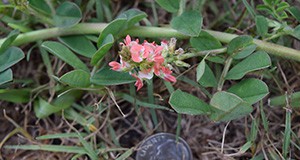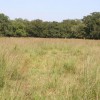Whitehead broom, also known as shrubby false buttonweed or southern larraflower, is becoming problematic in south Florida pastures, hayfields, and rights-of-way. This 2-page fact sheet discusses a few options to control this species. Written by Brent Sellers and James McWhorter, and published by the UF Agronomy Department, August 2016.
http://edis.ifas.ufl.edu/ag409
Tag: Range Cattle REC
Creeping Indigo, A Poisonous Plant of Concern in Florida Pastures
 A recent rise in suspected horse poisonings has brought new attention to creeping indigo (Indigofera spicata), a toxic plant which has reportedly been in Florida for as long as 90 years. This new 5-page fact sheet covers plant description, signs of creeping indigo toxicity, and roles of creeping indigo’s toxins, as well as treatment and management. Written by Robert MacKay, Ed Jennings, Brent Sellers, Jason Ferrell, and Amanda House, and published by the UF Department of Agronomy, August 2015.
A recent rise in suspected horse poisonings has brought new attention to creeping indigo (Indigofera spicata), a toxic plant which has reportedly been in Florida for as long as 90 years. This new 5-page fact sheet covers plant description, signs of creeping indigo toxicity, and roles of creeping indigo’s toxins, as well as treatment and management. Written by Robert MacKay, Ed Jennings, Brent Sellers, Jason Ferrell, and Amanda House, and published by the UF Department of Agronomy, August 2015.
http://edis.ifas.ufl.edu/ag399
Smutgrass Control in Perennial Grass Pastures
 Smutgrass is a serious weed of improved perennial grass pastures, roadsides, natural areas, and waste areas in Florida. A 2003 survey found that smutgrass was second only to tropical soda apple as the most problematic weed species in Florida pastures, but now that practices to control tropical soda apple have been widely adopted in Florida, smutgrass is likely the most problematic weed species in Florida pastures today. This 4-page fact sheet was written by Brent Sellers, J. A. Ferrell, and N. Rana, and published by the UF Department of Agronomy, January 2015. (Photo Credit: B. Sellers, UF/IFAS)
Smutgrass is a serious weed of improved perennial grass pastures, roadsides, natural areas, and waste areas in Florida. A 2003 survey found that smutgrass was second only to tropical soda apple as the most problematic weed species in Florida pastures, but now that practices to control tropical soda apple have been widely adopted in Florida, smutgrass is likely the most problematic weed species in Florida pastures today. This 4-page fact sheet was written by Brent Sellers, J. A. Ferrell, and N. Rana, and published by the UF Department of Agronomy, January 2015. (Photo Credit: B. Sellers, UF/IFAS)
http://edis.ifas.ufl.edu/aa261
Targeting ADG of Developing Replacement Heifers Using Age and Body Weight
 Heifer development continues to be one of the largest expenses to cow-calf operations, primarily due to cost of feed. Replacement heifers should be bred to calve at 24 months of age in order to maximize lifetime productivity of breeding females. Therefore, heifers should conceive at 15 months of age and achieve puberty at 13–14 months of age because heifers are infertile on the pubertal estrous cycle. This 4-page fact sheet was written by Phillip Lancaster and Cliff Lamb, and published by the UF Department of Animal Sciences, September 2014.
Heifer development continues to be one of the largest expenses to cow-calf operations, primarily due to cost of feed. Replacement heifers should be bred to calve at 24 months of age in order to maximize lifetime productivity of breeding females. Therefore, heifers should conceive at 15 months of age and achieve puberty at 13–14 months of age because heifers are infertile on the pubertal estrous cycle. This 4-page fact sheet was written by Phillip Lancaster and Cliff Lamb, and published by the UF Department of Animal Sciences, September 2014.
http://edis.ifas.ufl.edu/an305
SSAGR334/AG344 Weed Management in Limpograss
SSAGR344, a 3-page fact sheet by Brent Sellers and Jason Ferrell, clarifies recommendations for weed control in limpograss pastures and hayfields. Published by the UF Department of Agronomy, May 2010.
http://edis.ifas.ufl.edu/ag344
SSAGR59/AA197 ‘Callide’ Rhodesgrass
Revised! SS-AGR-59, a 4-page fact sheet by J. Vendramini, A. Blount, Y. Newman, C. G. Chambliss and M. B. Adjei, describes this robust, warm-season perennial grass native from Africa, useful in southern Florida for fall and winter grazing — establishment, management of established stands, and pests. Includes references. Published by the UF Department of Agronomy, March 2010.
http://edis.ifas.ufl.edu/aa197
SSAGR87/AG267 Forage Grass Tolerance to Pasture Herbicides
Revised! SS-AGR-87, a 2-page illustrated fact sheet by Brent A. Sellers and Jason A. Ferrell, describes the tolerance of forage cultivars grown in Florida to herbicides currently registered for use in pastures. Published by the UF Department of Agronomy, May 2010.
http://edis.ifas.ufl.edu/ag267
SSAGR257/AG243 Managing Bahiagrass in Bermudagrass and Stargrass Pastures
Revised! SS-AGR-257, a 4-page illustrated fact sheet by B. A. Sellers and J. A. Ferrell, describes how to prevent encroachment by bahiagrassinto bermudagrass and stargrass pastures in Florida, and provides recommendations for chemical control, the impact of herbicide applications, and how to reduce forage-yield loss. Published by the UF Department of Agronomy, November 2009.
http://edis.ifas.ufl.edu/AG243
SSAGR328/AG338 Mile-a-minute (Mikania micrantha): A New Weed in South Florida
SSAGR328, a 2-page illustrated fact sheet by Brent Sellers and Ken Langeland, describes this new weed, a highly branched perennial vine, reported in late 2009 near Homestead FL, and how to identify it and what to do if you find it. Published by the UF Department of Agronomy, January 2010.
http://edis.ifas.ufl.edu/ag338
SSAGR231/AG321 Range Cattle Research and Education Center Climatological Report–2007
SS-AGR-231, a 7-page illustrated research report by Brent Sellers, presents a summary of rainfall, air temperature, evapotranspiration, and solar radiation for 2007 obtained at the Range Cattle Research and Education Center (REC) in Ona, Florida, and is compared to a 66-year summary of data collected from this location. Published by the UF Department of Agronomy, September 2009.
http://edis.ifas.ufl.edu/AG321
SSAGR18/AA261 Smutgrass Control in Perennial Grass Pastures
Revised! SS-AGR-18, a 4-page illustrated fact sheet by Brent Sellers, J. A. Ferrell, and J. J. Mullahey, describes the biology, outlines control recommendations for this serious weed of improved perennial grass pastures, roadsides, natural areas, and waste areas in Florida. Published by the UF Department of Agronomy, November 2009.
http://edis.ifas.ufl.edu/AA261
AN230 Livestock Fence Construction
AN230, a 5-page illustrated fact sheet by Reyna Speckmann and Jeff Steele, describes the materials and assembly guides that are standard operating procedures practiced at the UF/IFAS Range Cattle Research and Education Center in Ona, FL. Published by the UF Department of Animal Sciences, November 2009.
http://edis.ifas.ufl.edu/AN230
SSAGR321/AG331 Pasture Aeration
SS-AGR-321, a 2-page illustrated fact sheet by Joao Vendramini and Maria Silveira, presents the results of research conducted at the Range Cattle Research and Education Center in Ona to test the efficiency of aeration in increasing forage production on soils typical in Florida. Includes references. Published by the UF Department of Agronomy, May 2009.
http://edis.ifas.ufl.edu/AG331
